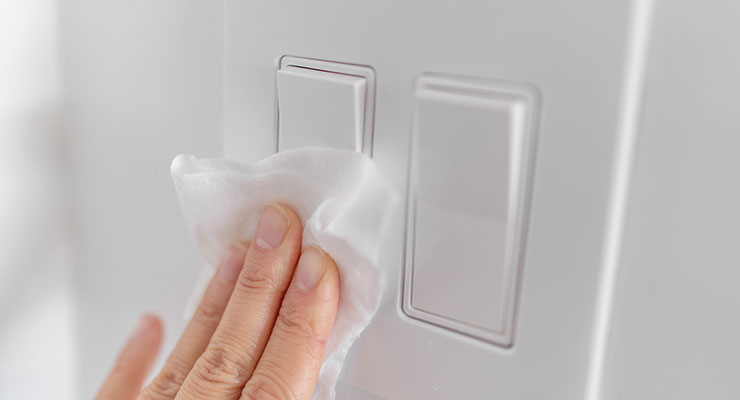John Nelson, editor, Smithers04.04.24
Wipes continue to be one of the most dynamic segments of the nonwovens industries. Demand for wipes and the market;s production footprint were both boosted by Covid, and a range of new premium formats were launched in 2023 and 2024. Countering this is the long-term concern over their environmental impact, which is stimulating investment into more sustainable material sets.
Data from the forthcoming Smithers report—The Future of Global Nonwoven Wipes to 2029 [www.smithers.com/Services/market-reports/Nonwovens/The-Future-of-Global-Wipes-to-2029]—forecasts strong continued growth. World consumption will reach 1.7 million tons according to Smithers expert market modeling, equivalent to an extra 445,200 tons of demand since 2019. Continued market expansion will see this total increase further to 2.31 million in 2029, Smithers forecasts.
Annual sales value did peak during Covid and its immediate aftermath. Wipes reported a surge in sales of over $6 billion between 2019 and 2022 to reach a global value of $23.71 billion. In the short term, demand is scheduled to fall as cleaning mandates are withdrawn, infection fears recede, and strategic stockpiles are secured, and even run down. This will see total demand fall back to $23.06 billion in 2024. Positive growth in wipes sales will return in 2026, however. A compound annual growth rate (CAGR) of 6.1% for 2024-2029 will drive global sales values above $30 billion for the first time before the end of the decade.
Smithers analysis is based on its in-depth knowledge of the nonwovens wipes market, shifting end-use demands, regulatory and material trends and the insight this gives into each of the four major wipe market segments:
Baby wipes are under pressure because of their poor flushability properties. The sheer volume of this mrket has made them a main contributor to blocked sewers and marine pollution. Standard nonwoven baby wipes remain cheaper and more readily available than dedicated adult moist toilet tissues, and investment in better consumer education will continue to be the preferred option to combat this. In some instances these are now being mandated, alongside compulsory non-flush product labeling, via legislation like the EU’s Single-use Plastics Directive.
Historically the wet strength requirements have prohibited a transition to a fully flushable baby wipe construction; although options are now emerging in the form of hydroentangled wetlaid substrates. Even when this becomes technically feasible, practical opposition to introducing these will remain. Both EDANA and INDA fear that even a limited market introduction of these would cause a rise in flushing of these non-flushable formats, which would continue to be the vast majority of market volume.
More sustainable material sets are still proving more popular; in Europe, noticeably, more polymer-free baby wipes are on sale. Made with viscose, lyocell or cotton spunlace some now leverage the new carded/wetlaid pulp (CP wet) spunlace process. There is limited capacity for these in 2024, but this is projected to grow across the Smithers forecast period. As the market evolves there may also be potential for the deployment of greener modified carboxymethyl cellulose binders for airlaid and bioplastic polyhydroxyalkanoates (PHAs) for Coform and spunlace fibers.
The retail price for these products can be two to eight times more than the average cost of of a pack of baby wipes. Personal care wipes are the most discretionary type of wipe however—and most susceptible to macroeconomic conditions—with consumers reverting to cheaper types, or discontinuing use, when household budgets are constrained.
Diversification continues in personal care wipes with new formats including—pre- and post-spa wipes, self-tanning wipes, skin rejuvenation wipes, ultra-light facial lotion infused wipes, deodorant wipes and even post-beach cleansing wipes.
A noticeable latent effect remains, however. Demand is still well above pre-pandemic volumes, and will stay there, with annual growth forecast to exceed the market average during the next five years. This will provide an outlet for several of the new converting lines ordered or installed as emergency measures during Covid.

The main sub-segment by volume are general-purpose industrial wipes, which see spunlace, airlaid, wetlaid (DRC), carded, composites and spunlaid nonwovens employed for cleaning, polishing and surface preparation tasks.
Specialty nonwoven industrial wipes have a smaller share by volume but higher unit prices. Future growth in sales will shadow recovery in certain specific industries, such as electronics production, and automotive manufacturing. Positive projections for these make them the fastest growing industrial wipes segment across the Smithers forecast period.
Demand for food service wipes continued to recover from Covid-related closures earlier in the decade. However, it remains the slowest growing segment of industrial wipes and is now the smallest by volume, having been overtaken by both specialty and healthcare wipes in 2021.
Healthcare wipes are employed in hospital and other medical facilities, for a range of tasks. Sales saw a major boost during Covid-19, and post-pandemic medical services remain bust with some additional cleaning procedures now accepted as standard preventive practices. Consequently healthcare wipes are projected to grow at above average rates through 2029.
The Future of Global Nonwovens Wipes to 2029 is a forthcoming authoritative market data study from Smithers. This segments the market by raw material, nonwoven web forming process, end-use application, geographic region, and national market.
For more information and to claim an exclusive pre-publication discount please contact Smithers today, shill@smithers.com.
Data from the forthcoming Smithers report—The Future of Global Nonwoven Wipes to 2029 [www.smithers.com/Services/market-reports/Nonwovens/The-Future-of-Global-Wipes-to-2029]—forecasts strong continued growth. World consumption will reach 1.7 million tons according to Smithers expert market modeling, equivalent to an extra 445,200 tons of demand since 2019. Continued market expansion will see this total increase further to 2.31 million in 2029, Smithers forecasts.
Annual sales value did peak during Covid and its immediate aftermath. Wipes reported a surge in sales of over $6 billion between 2019 and 2022 to reach a global value of $23.71 billion. In the short term, demand is scheduled to fall as cleaning mandates are withdrawn, infection fears recede, and strategic stockpiles are secured, and even run down. This will see total demand fall back to $23.06 billion in 2024. Positive growth in wipes sales will return in 2026, however. A compound annual growth rate (CAGR) of 6.1% for 2024-2029 will drive global sales values above $30 billion for the first time before the end of the decade.
Smithers analysis is based on its in-depth knowledge of the nonwovens wipes market, shifting end-use demands, regulatory and material trends and the insight this gives into each of the four major wipe market segments:
- Baby wipes
- Personal care wipes
- Homecare wipes
- Industrial wipes
Baby Wipes
Baby wipes is the largest and most established segment of this market. Worth $6.84 billion in 2024, it is also the least dynamic. Global demand is now slowing after over 20 years of expansion, reflecting deep penetration into developed markets where they are now accepted as standard equipment for new parents. Conversely, there is evidence that some home care and personal care wipes already approached maturity or hit maximum sales after only five to 10 years.Baby wipes are under pressure because of their poor flushability properties. The sheer volume of this mrket has made them a main contributor to blocked sewers and marine pollution. Standard nonwoven baby wipes remain cheaper and more readily available than dedicated adult moist toilet tissues, and investment in better consumer education will continue to be the preferred option to combat this. In some instances these are now being mandated, alongside compulsory non-flush product labeling, via legislation like the EU’s Single-use Plastics Directive.
Historically the wet strength requirements have prohibited a transition to a fully flushable baby wipe construction; although options are now emerging in the form of hydroentangled wetlaid substrates. Even when this becomes technically feasible, practical opposition to introducing these will remain. Both EDANA and INDA fear that even a limited market introduction of these would cause a rise in flushing of these non-flushable formats, which would continue to be the vast majority of market volume.
More sustainable material sets are still proving more popular; in Europe, noticeably, more polymer-free baby wipes are on sale. Made with viscose, lyocell or cotton spunlace some now leverage the new carded/wetlaid pulp (CP wet) spunlace process. There is limited capacity for these in 2024, but this is projected to grow across the Smithers forecast period. As the market evolves there may also be potential for the deployment of greener modified carboxymethyl cellulose binders for airlaid and bioplastic polyhydroxyalkanoates (PHAs) for Coform and spunlace fibers.
Personal Care Wipes
Personal care is a rapidly evolving segment of the wipes market. It has a wide variety of applications including several smaller, more specialized, types—adult moist toilet tissue, toddler toilet care, cosmetics and facial, bath and adult incontinence, feminine hygiene, and others. Combined these will consume 182,100 tons of nonwovens in 2024, and will be worth $4.57 billion.The retail price for these products can be two to eight times more than the average cost of of a pack of baby wipes. Personal care wipes are the most discretionary type of wipe however—and most susceptible to macroeconomic conditions—with consumers reverting to cheaper types, or discontinuing use, when household budgets are constrained.
Diversification continues in personal care wipes with new formats including—pre- and post-spa wipes, self-tanning wipes, skin rejuvenation wipes, ultra-light facial lotion infused wipes, deodorant wipes and even post-beach cleansing wipes.
Homecare Wipes
The homecare market is still reacting to the major spike in demand at the beginning of the decade, when surface cleaning became a key measure to protect against Covid infection. This has now fallen back, with recessionary pressures leading consumers to reduce their household cleaning spending. In 2024 Smithers forecast total global consumption of 240,100 tons of nonwovens in homecare wipes, with a value of $7.90 billion.A noticeable latent effect remains, however. Demand is still well above pre-pandemic volumes, and will stay there, with annual growth forecast to exceed the market average during the next five years. This will provide an outlet for several of the new converting lines ordered or installed as emergency measures during Covid.
Industrial Wipes
Industrial wipes are a distinct segment, and sales closely follow the outlook for end-use sectors—manufacturing, healthcare, food-service, automotive construction, metal products and electronics. Combined these will be worth $4.30 billion to wipe manufacturers in 2024 and will consume 450,700 tons of nonwovens.
The main sub-segment by volume are general-purpose industrial wipes, which see spunlace, airlaid, wetlaid (DRC), carded, composites and spunlaid nonwovens employed for cleaning, polishing and surface preparation tasks.
Specialty nonwoven industrial wipes have a smaller share by volume but higher unit prices. Future growth in sales will shadow recovery in certain specific industries, such as electronics production, and automotive manufacturing. Positive projections for these make them the fastest growing industrial wipes segment across the Smithers forecast period.
Demand for food service wipes continued to recover from Covid-related closures earlier in the decade. However, it remains the slowest growing segment of industrial wipes and is now the smallest by volume, having been overtaken by both specialty and healthcare wipes in 2021.
Healthcare wipes are employed in hospital and other medical facilities, for a range of tasks. Sales saw a major boost during Covid-19, and post-pandemic medical services remain bust with some additional cleaning procedures now accepted as standard preventive practices. Consequently healthcare wipes are projected to grow at above average rates through 2029.
The Future of Global Nonwovens Wipes to 2029 is a forthcoming authoritative market data study from Smithers. This segments the market by raw material, nonwoven web forming process, end-use application, geographic region, and national market.
For more information and to claim an exclusive pre-publication discount please contact Smithers today, shill@smithers.com.













